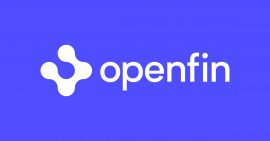Adam Toms, global COO of OpenFin and CEO of OpenFin Europe, highlights how his team is empowering firms to maximise the value of the powerful tools that already exist on their user desktops.

Adam Toms, OpenFin: How to maximise the value of the powerful desktop tools
What are some of the most significant pain points experienced by capital markets firms today? How have they evolved in response to the pandemic?
There continues to be a rapid pace of innovation and delivery of many applications, data services and insights, which is fantastic for the industry. However, this creates more complexity on the desktop for end users as they leverage several apps and work to digest vast amounts of data.
As a direct result of the inevitable context switching and time wasted on trying to surface impactful insights, there is a dramatic loss in productivity, as well as a significant increase in operational risk. All that adds up to end users feeling the brunt of a terrible desktop experience.
One thing we learned from the pandemic is that employee expectations have changed dramatically. It is clear that employees are thinking critically about what is important to them, and that they prize work environments that empower them to be more efficient and more effective – they’re no longer willing to compromise here.
And of course, we have this continued trend of consumer technology developing in leaps and bounds, and therefore a growing desire from users to bring these consumer experiences to the enterprise level.
What tools can alleviate the various market and economic pressures that firms may be facing today?
There continues to be an industry-wide reckoning – that is, firms are really trying to evaluate where they are spending money and ensuring they can drive areas of value and conversely cost reduction. One area that has proven to be particularly important is optimising the use of apps that your organisation has already invested in – and that means helping users get the most out of them to be more productive.
As the OS for enterprise productivity, OpenFin is working to do just that. We consistently deliver on increasing productivity and lowering operational risk and technology costs. That’s why we continue to see a steady increase in demand for our products and services despite the slowing economic back drop
What is it about OpenFin’s Workspace solution that has led to such significant adoption by the industry?
We are seeing firms continue to invest in the types of tools they are providing to their employees. In the time since we launched it last year, Workspace has grown dramatically because of its time to value – setting it up requires few resources and minimal time. Employees can reap the benefits very quickly, which is a key focus for our clients.
With Workspace, apps no longer work in isolation – they function as part of a unified workflow with an extensive set of features designed to increase productivity and keep end users happy. These users can create individual views around tasks and stand up dynamic workflows using OpenFin Browser, which has built-in interoperability. They can use OpenFin Home to source information from their entire desktop and any data end-point. They can receive dynamic alerts and make rapid decisions through OpenFin Notification Centre. All these capabilities work seamlessly with other core tools on the desktop, including Excel, Microsoft Teams and other critical applications.
How does OpenFin’s approach to development enable you to serve clients with differentiated product offerings?
I think there are two parts to this answer: one on what you can see and one on what you can’t. The visible components are incredibly well designed and built in collaboration with our clients, whether they be major banks, asset managers or wealth managers. This sense of partnership is a very high priority for us – really understanding end-user requirements and then putting our highly specialised design team to work on building an outstanding experience for employees. This is absolutely crucial in product design today, and a big reason why Workspace is so well respected.
Then there are the aspects you can’t necessarily see. Crafting these solutions requires a significant amount of engineering. One of the most critical areas that we have continued to focus on is security – a long-standing aspect of OpenFin technology that is now more important than ever. OpenFin is co-stable with Chromium, and our strict SLA for 0-day patches has proven to be essential for clients.
Our multitenant infrastructure and highly sophisticated deployment model further power our development approach. It is because of these strong foundations that customers are trusting us with their largest, most strategic projects.
What are the keys to employee productivity? How does OpenFin help support them?
In examining how our clients operate, we have determined that there are two types of tasks employees can execute: discretionary tasks and process-driven tasks, which are more repetitive. Our technology is able to meet the needs of both. For discretionary tasks, employees need timely, easily accessible information that highlights the most relevant and useful data. For process-driven tasks, users need optimised workflows and interoperability, and that comes from an interconnected desktop.
Ultimately, we are giving time back to employees. We reduce the time they spend on tasks while simultaneously empowering them with the best possible information to maximise productivity and value.
What’s next for Workspace and OpenFin as we look ahead to 2023?
The issues surrounding the current state of workplace technology are universal, and our intelligent OS is one that can address these problems across many different sectors. You may have seen recently our strategic funding from In-Q-Tel, marking our first large-scale use case outside of finance.
While we remain committed to the financial services industry, we believe there are a wealth of lessons from other industries that can be applied to the financial desktop, and vice versa. When I talk to clients, they do not necessarily see their problems as industry-specific – it’s so much bigger than that.
Over a decade into OpenFin’s history, we are proud to be a high-growth company and to be starting our journey of branching out across sectors.
About Adam Toms
Adam Toms is global COO of OpenFin and CEO of OpenFin Europe, where he is responsible for driving digital transformation via OpenFin’s operating system.
Through industry engagement and collaboration with both client teams and internal staff, his goal is for OpenFin OS to serve as the backbone for the future of finance, offering efficiencies in terms of software delivery, security and workflows.
Before joining OpenFin, Toms was CEO of Instinet Europe, where he was responsible for managing the firm’s brokerage operations and business strategy in the EMEA region. Under his leadership, Instinet achieved record market share and profitability.

Credit: Source link


Comments are closed.